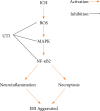Ulinastatin alleviates early brain injury after intracerebral hemorrhage by inhibiting necroptosis and neuroinflammation via MAPK/NF-κB signaling pathway
- PMID: 35584533
- PMCID: PMC9109988
- DOI: 10.1590/acb370301
Ulinastatin alleviates early brain injury after intracerebral hemorrhage by inhibiting necroptosis and neuroinflammation via MAPK/NF-κB signaling pathway
Abstract
Purpose: Spontaneous intracerebral hemorrhage (ICH) is a major public health problem with a huge economic burden worldwide. Ulinastatin (UTI), a serine protease inhibitor, has been reported to be anti-inflammatory, immune regulation, and organ protection by reducing reactive oxygen species production, and inflammation. Necroptosis is a programmed cell death mechanism that plays a vital role in neuronal cell death after ICH. However, the neuroprotection of UTI in ICH has not been confirmed, and the potential mechanism is unclear. The present study aimed to investigate the neuroprotection and potential molecular mechanisms of UTI in ICH-induced EBI in a C57BL/6 mouse model.
Methods: The neurological score, brain water content, neuroinflammatory cytokine levels, and neuronal damage were evaluated. The anti-inflammation effectiveness of UTI in ICH patients also was evaluated.
Results: UTI treatment markedly increased the neurological score, alleviate the brain edema, decreased the inflammatory cytokine TNF-α, interleukin‑1β (IL‑1β), IL‑6, NF‑κB levels, and RIP1/RIP3, which indicated that UTI-mediated inhibition of neuroinflammation, and necroptosis alleviated neuronal damage after ICH. UTI also can decrease the inflammatory cytokine of ICH patients. The neuroprotective capacity of UTI is partly dependent on the MAPK/NF-κB signaling pathway.
Conclusions: UTI improves neurological outcomes in mice and reduces neuronal death by protecting against neural neuroinflammation, and necroptosis.
Conflict of interest statement
Conflict of interest: Nothing to declare.
Figures







Similar articles
-
Ulinastatin alleviates early brain injury after intracerebral hemorrhage by inhibiting oxidative stress and neuroinflammation via ROS/MAPK/Nrf2 signaling pathway.Acta Cir Bras. 2022 Sep 5;37(6):e370606. doi: 10.1590/acb370606. eCollection 2022. Acta Cir Bras. 2022. PMID: 36074399 Free PMC article.
-
Perampanel, an AMPAR antagonist, alleviates experimental intracerebral hemorrhage‑induced brain injury via necroptosis and neuroinflammation.Mol Med Rep. 2021 Aug;24(2):544. doi: 10.3892/mmr.2021.12183. Epub 2021 Jun 3. Mol Med Rep. 2021. PMID: 34080030 Free PMC article.
-
Ulinastatin alleviates early brain injury after traumatic brain injury by inhibiting oxidative stress and apoptosis.Acta Cir Bras. 2022 Apr 20;37(1):e370108. doi: 10.1590/acb370108. eCollection 2022. Acta Cir Bras. 2022. PMID: 35475892 Free PMC article.
-
MicroRNAs modulate neuroinflammation after intracerebral hemorrhage: Prospects for new therapy.Front Immunol. 2022 Nov 1;13:945860. doi: 10.3389/fimmu.2022.945860. eCollection 2022. Front Immunol. 2022. PMID: 36389834 Free PMC article. Review.
-
The extracellular matrix as modifier of neuroinflammation and recovery in ischemic stroke and intracerebral hemorrhage.Neurobiol Dis. 2023 Oct 1;186:106282. doi: 10.1016/j.nbd.2023.106282. Epub 2023 Sep 6. Neurobiol Dis. 2023. PMID: 37683956 Review.
Cited by
-
A Pair of Epimers of Lignan Alleviate Neuroinflammatory Effects by Modulating iNOS/COX-2 and MAPK/NF-κB Signaling Pathways.Inflammation. 2025 Feb;48(1):361-371. doi: 10.1007/s10753-024-02080-9. Epub 2024 Jun 15. Inflammation. 2025. PMID: 38878150
-
Ulinastatin Alleviates Repetitive Ketamine Exposure-Evoked Cognitive Impairment in Adolescent Mice.Neural Plast. 2022 Dec 12;2022:6168284. doi: 10.1155/2022/6168284. eCollection 2022. Neural Plast. 2022. PMID: 36545238 Free PMC article.
-
Exploring and Validating the Mechanism of Ulinastatin in the Treatment of Sepsis-Associated Encephalopathy Based on Transcriptome Sequencing.J Inflamm Res. 2024 Nov 14;17:8753-8773. doi: 10.2147/JIR.S488400. eCollection 2024. J Inflamm Res. 2024. PMID: 39564549 Free PMC article.
-
The role of hydrogen sulfide in the regulation of necroptosis across various pathological processes.Mol Cell Biochem. 2025 Apr;480(4):1999-2013. doi: 10.1007/s11010-024-05090-1. Epub 2024 Aug 14. Mol Cell Biochem. 2025. PMID: 39138751 Review.
-
Therapeutic Potential of TUBB6 Inhibition for Hematoma Reduction, Microtubule Stabilization, and Neurological Recovery in an In Vivo Model of Intracerebral Hemorrhage.Neuromolecular Med. 2025 Feb 20;27(1):15. doi: 10.1007/s12017-025-08838-0. Neuromolecular Med. 2025. PMID: 39979490
References
-
- Zhang Y, Zhang X, Wei Q, Leng S, Li C, Han B, Bai Y, Zhang H, Yao H. Activation of sigma-1 receptor enhanced pericyte survival via the interplay between apoptosis and autophagy: implications for blood-brain barrier integrity in stroke. Transl Stroke Res. 2020;11(2):267–287. doi: 10.1007/s12975-019-00711-0. - DOI - PubMed
-
- Hanley DF, Thompson RE, Rosenblum M, Yenokyan G, Lane K, McBee N, Mayo SW, Bistran-Hall AJ, Gandhi D, Mould WA, Ullman N, Ali H, Carhuapoma JR, Kase CS, Lees KR, Dawson J, Wilson A, Betz JF, Sugar EA, Hao Y, Avadhani R, Caron JL, Harrigan MR, Carlson AP, Bulters D, LeDoux D, Huang J, Cobb C, Gupta G, Kitagawa R, Chicoine MR, Patel H, Dodd R, Camarata PJ, Wolfe S, Stadnik A, Money PL, Mitchell P, Sarabia R, Harnof S, Barzo P, Unterberg A, Teitelbaum JS, Wang W, Anderson CS, Mendelow AD, Gregson B, Janis S, Vespa P, Ziai W, Zuccarello M, Awad IA. Efficacy and safety of minimally invasive surgery with thrombolysis in intracerebral haemorrhage evacuation (MISTIE III): a randomised, controlled, open-label, blinded endpoint phase 3 trial. Lancet. 2019;393(10175):1021–1032. doi: 10.1016/s0140-6736(19)30195-3. - DOI - PMC - PubMed
MeSH terms
Substances
LinkOut - more resources
Full Text Sources
Miscellaneous

